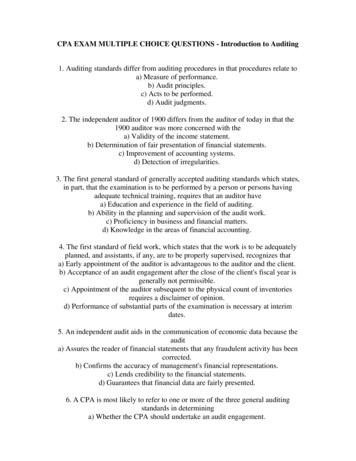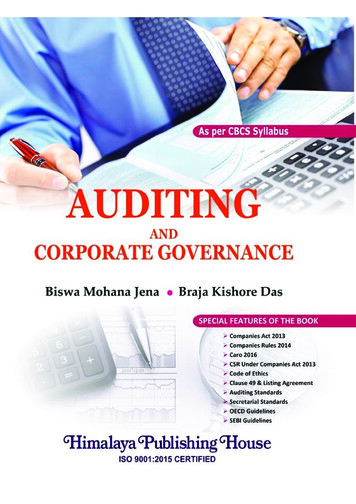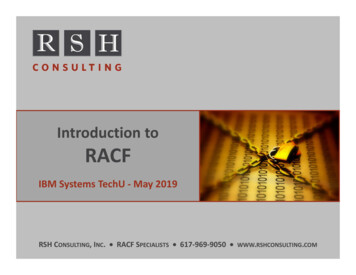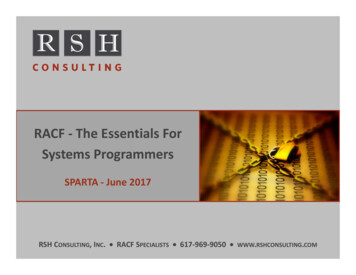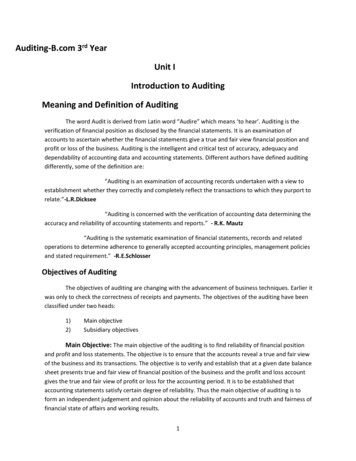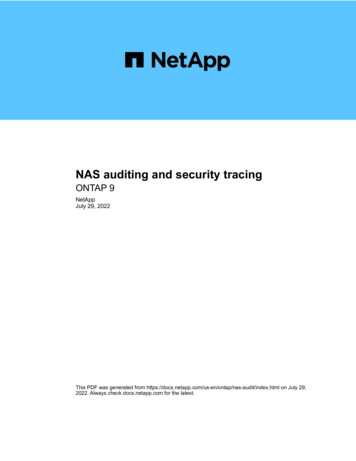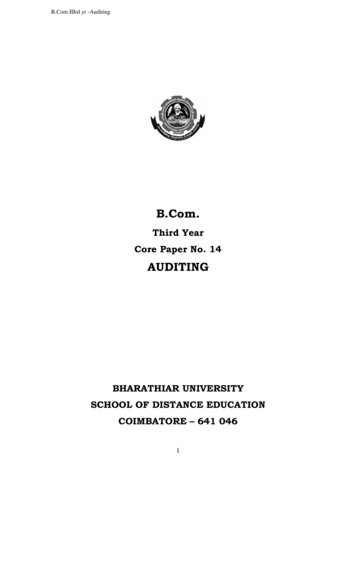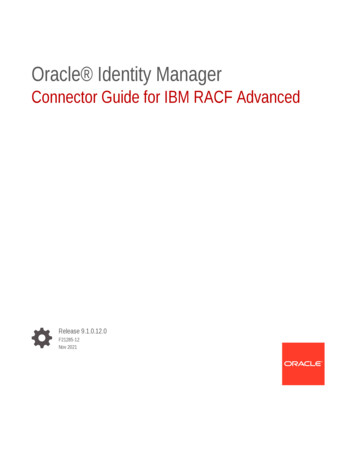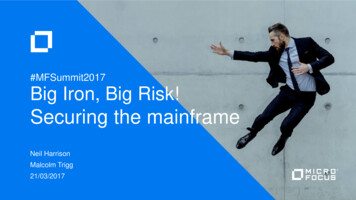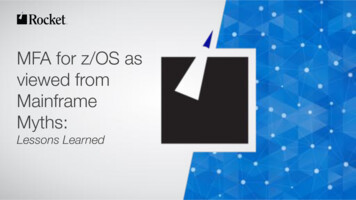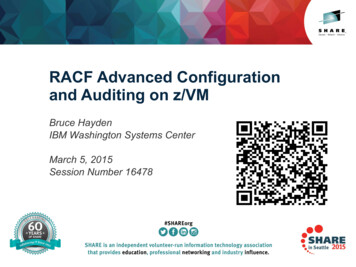
Transcription
RACF Advanced Configurationand Auditing on z/VMBruce HaydenIBM Washington Systems CenterMarch 5, 2015Session Number 16478
TrademarksThe following are trademarks of the International Business Machines Corporation in the United States, other countries, or both.Not all common law marks used by IBM are listed on this page. Failure of a mark to appear does not mean that IBM does not use the mark nor does it mean that the product is notactively marketed or is not significant within its relevant market.Those trademarks followed by are registered trademarks of IBM in the United States; all others are trademarks or common law marks of IBM in the United States.For a complete list of IBM Trademarks, see www.ibm.com/legal/copytrade.shtml:*, AS/400 , e business(logo) , DBE, ESCO, eServer, FICON, IBM , IBM (logo) , iSeries , MVS, OS/390 , pSeries , RS/6000 , S/30, VM/ESA , VSE/ESA,WebSphere , xSeries , z/OS , zSeries , z/VM , System i, System i5, System p, System p5, System x, System z, System z9 , BladeCenter The following are trademarks or registered trademarks of other companies.Adobe, the Adobe logo, PostScript, and the PostScript logo are either registered trademarks or trademarks of Adobe Systems Incorporated in the United States, and/or other countries.Cell Broadband Engine is a trademark of Sony Computer Entertainment, Inc. in the United States, other countries, or both and is used under license therefrom.Java and all Java-based trademarks are trademarks of Sun Microsystems, Inc. in the United States, other countries, or both.Microsoft, Windows, Windows NT, and the Windows logo are trademarks of Microsoft Corporation in the United States, other countries, or both.Intel, Intel logo, Intel Inside, Intel Inside logo, Intel Centrino, Intel Centrino logo, Celeron, Intel Xeon, Intel SpeedStep, Itanium, and Pentium are trademarks or registered trademarks of IntelCorporation or its subsidiaries in the United States and other countries.UNIX is a registered trademark of The Open Group in the United States and other countries.Linux is a registered trademark of Linus Torvalds in the United States, other countries, or both.ITIL is a registered trademark, and a registered community trademark of the Office of Government Commerce, and is registered in the U.S. Patent and Trademark Office.IT Infrastructure Library is a registered trademark of the Central Computer and Telecommunications Agency, which is now part of the Office of Government Commerce.* All other products may be trademarks or registered trademarks of their respective companies.Notes:Performance is in Internal Throughput Rate (ITR) ratio based on measurements and projections using standard IBM benchmarks in a controlled environment. The actual throughput that any user willexperience will vary depending upon considerations such as the amount of multiprogramming in the user's job stream, the I/O configuration, the storage configuration, and the workload processed. Therefore,no assurance can be given that an individual user will achieve throughput improvements equivalent to the performance ratios stated here.IBM hardware products are manufactured from new parts, or new and serviceable used parts. Regardless, our warranty terms apply.All customer examples cited or described in this presentation are presented as illustrations of the manner in which some customers have used IBM products and the results they may have achieved. Actualenvironmental costs and performance characteristics will vary depending on individual customer configurations and conditions.This publication was produced in the United States. IBM may not offer the products, services or features discussed in this document in other countries, and the information may be subject to change withoutnotice. Consult your local IBM business contact for information on the product or services available in your area.All statements regarding IBM's future direction and intent are subject to change or withdrawal without notice, and represent goals and objectives only.Information about non-IBM products is obtained from the manufacturers of those products or their published announcements. IBM has not tested those products and cannot confirm the performance,compatibility, or any other claims related to non-IBM products. Questions on the capabilities of non-IBM products should be addressed to the suppliers of those products.Prices subject to change without notice. Contact your IBM representative or Business Partner for the most current pricing in your geography.22 2015 IBM Corporation
Notice Regarding Specialty Engines (e.g., zIIPs,zAAPs and IFLs):Any information contained in this document regarding Specialty Engines ("SEs") and SEeligible workloads provides only general descriptions of the types and portions of workloadsthat are eligible for execution on Specialty Engines (e.g., zIIPs, zAAPs, and IFLs). IBMauthorizes customers to use IBM SE only to execute the processing of Eligible Workloads ofspecific Programs expressly authorized by IBM as specified in the “Authorized Use Table forIBM Machines” provided atwww.ibm.com/systems/support/machine warranties/machine code/aut.html (“AUT”).No other workload processing is authorized for execution on an SE.IBM offers SEs at a lower price than General Processors/Central Processors becausecustomers are authorized to use SEs only to process certain types and/or amounts ofworkloads as specified by IBM in the AUT. 2015 IBM Corporation
2015 IBM CorporationRACF Advanced Configuration and Auditing on z/VMAgenda Generic Resources Directory Passwords DIRMAINT Customizing Error Recovery Auditing Reporting4IBM Washington Systems Center
2015 IBM CorporationRACF Advanced Configuration and Auditing on z/VMRACF Advanced Configuration and Auditing on z/VMGenericResources5
2015 IBM CorporationRACF Advanced Configuration and Auditing on z/VMIntroduction to Generic resources Single resources are defined to RACF For minidisks – a specific virtual address owned by a user For a virtual lan – a specific vswitch and vlanIn RACF terms – a “discrete profile” RACF also supports generic resources 6A lot like wildcard matching of file namesMore restrictive definitions and discrete profiles have priorityExample:Only allow the OPERATOR user id to log on to a local terminal Allow any user to log on to any terminal and also local terminals– RDEFINE TERMINAL * UACC(READ)– RDEFINE TERMINAL LOGN* UACC(READ) Only allow the OPERATOR to log on to local terminals by not allowing it to log on to“all terminals”– PERMIT * CLASS(TERMINAL) ID(OPERATOR) ACCESS(NONE)IBM Washington Systems Center
2015 IBM CorporationRACF Advanced Configuration and Auditing on z/VMGeneric resources Enabled via RACF options (SETROPTS command) GENCMD(classes) Allows generic profiles to be specified in commands You can create generic profiles before making them active GENERIC(classes) Activates generic profile checking for specified classes Also allows generic profiles in commands Not enabled on any classes by default Due to extra searching, and not part of old RACF systems This can make managing your system easier! Fewer resources to define and manage Some resources only need controls for the exceptions7IBM Washington Systems Center
2015 IBM CorporationRACF Advanced Configuration and Auditing on z/VMCandidates for Generic ResourcesVMRDR (spooling) To send a file to another user, you must be permitted in RACF to “update” their reader i.e. SPOOL PUN TO user, SPOOL PRT TO user, TRANSFER TO user, CLOSE TO user Without permission, the command fails A security policy may not require this control for most users 8Use a single generic resource instead of a definition per user The default permission is “update”, which allows access RAC RDEFINE VMRDR * UACC(UPDATE)If there are exceptions -- create specific resources for controlExample: Protect the reader of OPERATOR Define the resource with no default access allowed RAC RDEFINE VMRDR OPERATOR UACC(NONE) Allow an authorized user to send files RAC PERMIT OPERATOR CLASS(VMRDR) ID(PERFSVM) ACCESS(UPDATE)IBM Washington Systems Center
2015 IBM CorporationRACF Advanced Configuration and Auditing on z/VMGeneric Resources, continuedVMBATCH (set alternate user) – How to use with FTPSERVE Allows FTPSERVE to access your resources on your behalf – e.g. whenyou “log in” via an FTP client Instead of giving FTPSERVE explicit permission to your resources FTPSERVE uses Diag D4 to ask CP to set its alternate user to your user id If FTPSERVE has permission from RACF to your VMBATCH resource, CPallows it to be set Now FTPSERVE can access any resource you have permission for Define a generic resource for VMBATCH The default permission is no accessRAC RDEFINE VMBATCH * UACC(NONE)Allow the FTP server to be an alternate user to any idRAC PERMIT * CL(VMBATCH) ID(FTPSERVE) ACCESS(CONTROL)Exceptions for critical users such as MAINT can be defined A discrete permission (PERMIT) overrides a generic permission or universalaccess (UACC) An access permission of NONE overrides any higher permission RAC RDEFINE VMBATCH MAINT UACC(NONE) RAC PERMIT MAINT CLASS(VMBATCH) ID(FTPSERVE) ACCESS(NONE)9IBM Washington Systems Center
2015 IBM CorporationRACF Advanced Configuration and Auditing on z/VMGeneric Resources, continuedVMCMD – XAUTOLOG The XAUTOLOG command has a class G version Without RACF – target user must have XAUTOLOG in its directory entry authorizingthe class G user. With RACF – User must have READ permission to the VMCMD resourceXAUTOLOG.userid What if an unauthorized user issues XAUTOLOG and the resource is not defined?XAUTOLOG TCPIPRPIMGR055E COMMAND XAUTOLOG.TCPIP NOT DEFINED TO RACFHCPLGA6050E Your userid is not authorized to automatically logon userid TCPIP The command fails, but the message from RACF could be confusing I recommend defining a generic “backstop” resource RAC RDEFINE VMCMD XAUTOLOG.** UACC(NONE)Now the user would see this instead:XAUTOLOG TCPIPRPIMGR056E YOU ARE NOT AUTHORIZED TO ISSUE XAUTOLOG.TCPIPHCPLGA6050E Your userid is not authorized to automatically logon userid TCPIP10IBM Washington Systems Center
2015 IBM CorporationRACF Advanced Configuration and Auditing on z/VMRACF Advanced Configuration and Auditing on z/VMDirectory andDIRMAINT11
2015 IBM CorporationRACF Advanced Configuration and Auditing on z/VMSpecial Directory Passwords Some directory passwords have special meanings to CP NOLOGNOPASSAUTOONLYLBYONLYAct like the userid doesn't exist (no logon or spooling)Allow logon without a passwordDo not allow direct logon, only XAUTOLOGOnly allow LOGON BY, or XAUTOLOG With RACF active, things change a little NOLOG Works as before NOPASS Allows logon without password if user is not revoked in RACF AUTOONLY Works as before – direct logon is not allowed The password or pass phrase should be removed from the user in RACF This gives the user the “protected” attribute LBYONLY Ignored, now controlled by a profile in the SURROGAT class12IBM Washington Systems Center
2015 IBM CorporationRACF Advanced Configuration and Auditing on z/VMDIRMAINT with RACF Adding a new user Defines user to RACF (ADDUSER) Defines resources (RDEFINE) RACF command arguments are customizable Changes to users Same change is reflected to RACF – even password changes Setting it up Configuration file supplied with DIRMAINT: CONFIGRC SAMPDVH Rename and use it as supplied or customize it as needed. DIRMAINT reads all CONFIG* DATADVH files that it finds DIRMAINT will require: Read access to resource DIAG088 in the VMCMD class RACF SPECIAL authority APAR notes: Install APARs VM65494 and VM65526 (Included in new 1501 service level) Watch APAR VM65565 (no PTF yet)– Changes exits for RACF and correctly handles user written exits– Change to correctly process SUBCONFIGs and command options13IBM Washington Systems Center
2015 IBM CorporationRACF Advanced Configuration and Auditing on z/VMRACF Advanced Configuration and Auditing on z/VMCustomizingRACF14
2015 IBM CorporationRACF Advanced Configuration and Auditing on z/VMCustomizing the RACF – CP interface 7 “stub” CP modules used for the ESM interface HCPRPD, HCPRPF, HCPRPG, HCPRPI, HCPRPW, and HCPRWA z/VM 6.2 added HCPRPP ESM replaces these with its own code HCPRWA has the most common customization High Level Assembler is required to make changes before z/VM 6.2. If this is a problem – call the support center for assistance For z/VM 6.2 , Assembler F can be used to apply the customization This assembler is included with CMS and supported by the service tools 4 macros in HCPRWA you can customize RACSERV GLBLDISK SYSSEC ICHNGMAX15IBM Washington Systems Center
2015 IBM CorporationRACF Advanced Configuration and Auditing on z/VMCustomizing HCPRWA RACSERV macro Defines the name of a RACF service machineMaximum of 10 can be definedDefault defines user ids RACFVM and RACMAINTSpecialized RACF servers could be created Such as servicing SFS requests only and not used for CP GLBLDISK macro Defines a table of public read only minidisks No auditing or authorization checking done for read only access Avoids a call from CP to RACF Performance benefit for frequently linked public disks ICHNGMAX macro Defines the maximum number of GIDs for POSIX Only matters if you use OpenExtensions with RACF16IBM Washington Systems Center
2015 IBM CorporationRACF Advanced Configuration and Auditing on z/VMCustomizing HCPRWA, continued SYSSEC macro Defines the relationship between RACF’s response to an access request and thefinal disposition of that request by z/VM. Choices: Allow – Tell CP to allow the access Defer – Process the request as if RACF was not active (“Defer to CP”) Fail – Tell CP to not allow access Only classes VMMDISK, VMRDR, VMNODE, VMCMD, and VMLAN No choices on the response for other classes17RACF Response to z/VMChoices (default is underlined)Authorized (PERMIT)Allow or DeferAccess not authorized (FAIL)Defer or FailNot authorized, WARNINGDefer or FailResource not defined to RACFAllow, Defer, or FailIBM Washington Systems Center
2015 IBM CorporationRACF Advanced Configuration and Auditing on z/VMThe SYSSEC macro Using the WARNING response with Defer to CP Can help the transition to RACF things work as they did before, but you also get messagesControlled by the resource profile WARNING option on the RDEFINE or RALTER command Remove setting with RALTER . NOWARNINGAccess attempt is always written to the audit logAlso use NOTIFY to collect failed access attempts Response for resources undefined to RACF 18In other words – no RDEFINE has been doneDefer to CP is necessary when setting up RACFNot a good idea on a fully secured system Requests for something undefined should fail!IBM Washington Systems Center
2015 IBM CorporationRACF Advanced Configuration and Auditing on z/VMChanging HCPRWA and SYSSEC Create a more secure system – what about this setup?RACF Response to z/VMSettingAuthorized (PERMIT)AllowAccess not authorized (FAIL)FailNot authorized, WARNINGFailResource not defined to RACFFail IBM supplies a pre-built optional HCPRWA with these settings Part of the recommended configuration defined in thez/VM Secure Configuration Guide Called HCPRWAC See Appendix C of the Guide for how to build your system with it Do not change to this until RACF is configured!19IBM Washington Systems Center
2015 IBM CorporationRACF Advanced Configuration and Auditing on z/VMRACF messages This is an additional setting on the SYSSEC macro Defines if a RACF message shows for an authorization failure Along with the normal messages from CP ExampleCP LINK MAINT 191 291 RRRPIMGR032E YOU ARE NOT AUTHORIZED TO LINK TO MAINT.191HCPLNM298E MAINT 0191 not linked; request denied If DISKM NO is specified, the RPI message is not displayed Can only be specified for certain RACF classes VMMDISK, VMRDR, VMNODE, VMCMD, and VMLAN Default setting is Yes for all classes20IBM Washington Systems Center
2015 IBM CorporationRACF Advanced Configuration and Auditing on z/VMRACF Advanced Configuration and Auditing on z/VMProblems?21
2015 IBM CorporationRACF Advanced Configuration and Auditing on z/VMError Recovery Built-in redundancy 2 database disks 2 sets of code disks 2 servers (RACFVM for production, RACMAINT for test) 2 database disks (primary and backup) Updated in parallel Use the RVARY command to switch to the backup Then you must repair the primary Please note! The default location of both database disks is the same volume! I suggest you move one of them to another system volume. SSI cluster setup requires you to move each database to its own disk. There is also a utility to back up the database22IBM Washington Systems Center
2015 IBM CorporationRACF Advanced Configuration and Auditing on z/VMRACMAINT user RACMAINT exists to test updated (serviced or modified) RACF code SERVICE process loads updated code to alternate disks (“test” disks) Code to 6VMRAC30 505 instead of RACFVM 305 Common code to 6VMRAC30 29E instead of MAINT 19E CST to 6VMRAC30 590 instead of RACFVM 49023 RACMAINT always uses the alternate disks RACF test procedure (as stated in the program directory): IPL CP using parameter disk 2– On z/VM 6.2/6.3, this is extent 1 on the 6x0RL1 volume Specify the NOAUTOLOG start option XAUTOLOG RACMAINT RACMAINT will start AUTOLOG2 Note: RACROUTE calls may fail when RACMAINT is running RACF SERVMACH file on Y disk still points to RACFVMIBM Washington Systems Center
2015 IBM CorporationRACF Advanced Configuration and Auditing on z/VMRACMAINT in the service process After testing - put the serviced RACF code into production Done by PUT2PROD, like all other z/VM components RACFVM must be down and RACMAINT running for this process If you did not reIPL your system, then on OPERATOR:– FORCE RACFVM– XAUTOLOG RACMAINT After PUT2PROD – the same code is on both sets of disks So, RACMAINT can be used if RACFVM has problems Perform a normal IPL of your system after PUT2PROD24IBM Washington Systems Center
2015 IBM CorporationRACF Advanced Configuration and Auditing on z/VMError Recovery – RACF abend What happens if RACFVM dies? Only the active system operator can XAUTOLOG RACFVM or RACMAINT Any other use of XAUTOLOG is denied The active system operator can be discovered withCP QUERY SYSOPER Only an operator, RACFVM, and RACMAINT can log on Using the password in the CP directory!!! Make sure you know these and that they are not trivial! An “operator” is the primary system operator or an alternate operator id, asdefined in SYSTEM CONFIG To start RACF if you logon directly to the RACFVM id: CP IPL 490 RACSTART25IBM Washington Systems Center
2015 IBM CorporationRACF Advanced Configuration and Auditing on z/VMRACF Advanced Configuration and Auditing on z/VMAuditing26
2015 IBM CorporationRACF Advanced Configuration and Auditing on z/VMAuditing in RACF Many different things can be audited Access to resources RACF commands CP commands and z/VM events Actions performed by security administrators Changes to profiles Attempt to use unauthorized commands and more. Separation of duties All auditing settings and functions have separate controls User must have attribute AUDITOR to change settings Audit log RACF audit data are called SMF records System Management Facility27IBM Washington Systems Center
2015 IBM CorporationRACF Advanced Configuration and Auditing on z/VMWhat should you Audit? Look at your company security policy Find out what records must be kept and how long to keep them What data will you need if a security problem occurs? Settings to audit the actions of privileged users SAUDITLog all commands issued by SPECIAL users OPERAUDIT Log any accesses made by OPERATIONS users CMDVIOLLog all command violations (unauthorized usage) Settings to audit access attempts by class Keywords ALWAYS, NEVER, SUCCESSES, FAILURES Example: SETROPTS LOGOPTIONS(ALWAYS(SURROGAT)) Always log all attempts to use shared user ids Audit changes to profiles in a class Example: SETROPTS AUDIT(VMMDISK)28IBM Washington Systems Center
2015 IBM CorporationRACF Advanced Configuration and Auditing on z/VMAuditing specific users Enable UAUDIT in the user's profile (NOUAUDIT to turn off) ALTUSER BRUCE UAUDIT The following events are logged: All RACF commands issued by the user All additions, changes, or deletions that the user makes to RACF profiles All attempts that the user makes to access RACF protected resources Useful for special situations and users Security sensitive user or application Suspect user (system misuse or exceeding authority)29IBM Washington Systems Center
2015 IBM CorporationRACF Advanced Configuration and Auditing on z/VMAuditing CP commands and VM events A system event profile defines what to audit. The profile is defined in the VMXEVENT class Many things you can select to audit or not: All CP commands (182) By privilege level if the command has multiple privileges– Example: PURGE has Class A, B, C, D, E, and G versions Also all SET (168) and QUERY (377) subcommands All Diagnose instructions (87) 19 other special events Communication (IUCV and APPC) Spool files (create, open, delete, print) Maintenance CCWs, Restricted segments, VLAN sniffer mode Commands in the directory SCIF activity Restricted segments Operations (attach, dedicate, give) of real devices No VM commands or events are audited by default30IBM Washington Systems Center
2015 IBM CorporationRACF Advanced Configuration and Auditing on z/VMAuditing CP commands and VM events An event profile also defines RACF control of CP events e.g. CP commands such as LINK, diagnoses, and others An AUDITOR can only change the audit controls A SPECIAL (only) user cannot change audit controls Suggestion: The SPECIAL user creates the profile and creates the CP controls Gives ALTER permission for the profile to the auditor The auditor creates the audit controls. Event profiles can have any name More than one can exist in the database Normally only one is active for the system It is possible to have 1 of each kind (control and audit) active at the same time– but this is not recommended. A profile must be “refreshed” if it is changed31IBM Washington Systems Center
2015 IBM CorporationRACF Advanced Configuration and Auditing on z/VMSetup auditing – example Example – changing an existing profile named EVENTS1RACFRALTER VMXEVENT EVENTS1 ADDMEM(DIAG03C/AUDIT DIAG084/AUDIT)RALTER VMXEVENT EVENTS1 ADDMEM(DISPLAY.C/AUDIT STORE.C/AUDIT)RALTER VMXEVENT EVENTS1 ADDMEM(SEND.C/AUDIT SET.PASSWORD/AUDIT)RALTER VMXEVENT EVENTS1 ADDMEM(SET.SECUSER.C/AUDIT)RALTER VMXEVENT EVENTS1 ADDMEM(SET.SYSOPER/AUDIT LINK/AUDIT)SETEVENT REFRESH EVENTS1ENDTo see what the settings are: RAC SETEVENT LIST List the settings that are active on the system RAC RLIST VMXEVENT EVENTS1 List the settings in this profile32IBM Washington Systems Center
2015 IBM CorporationRACF Advanced Configuration and Auditing on z/VMAuditing specific users (the sequel) Create an event profile that applies only to one user Named USERSEL.userid, in the VMXEVENT class Completely overrides system profile for that user So – don't just specify the difference, specify everything Both CP control settings and audit settings You can audit more or less things than the system profile Examples Don't audit frequently used functions in trusted machines Do more auditing for an untrusted machine Test changes to proposed system wide audit settings Use SETEVENT REFRESH to enable Use SETEVENT RESET to disable33IBM Washington Systems Center
2015 IBM CorporationRACF Advanced Configuration and Auditing on z/VMThe RACFSMF user id Purpose is to archive the audit data (SMF records) RACFVM actually writes the audit log, not RACFSMF RACFSMF is normally logged off An IDENTITY user – runs on every member of a custer How often should you archive the data? Option 1: On a regular schedule Select daily or either weekly or monthly on a certain day Defined in the PROFILE EXEC on RACFSMF 191 Use automation software to xautolog RACFSMF daily It requests RACFVM to switch log disks Then, it archives the data on the (now) inactive log disk Option 2: Automatically when one log disk is full RACFVM automatically switches to the other disk RACFSMF is started by RACFVM It archives the data on the (now) inactive log disk34IBM Washington Systems Center
2015 IBM CorporationRACF Advanced Configuration and Auditing on z/VMWhich log option to choose? I recommend a regular schedule (option 1) RACFSMF started daily on each member Processes log daily, weekly, or monthly Depending on your choice in PROFILE EXEC Sample code is SMFPROF EXEC on RACFVM 305 No surprises due to errors or revoked id You must pass the RACF server id as console input data CP XAUTOLOG RACFSMF #RACFVM RACFSMF sends messages to the operator Both informational and error messages Ensures the inactive log disk is empty Available for RACFVM if active log disk fills up35IBM Washington Systems Center
2015 IBM CorporationRACF Advanced Configuration and Auditing on z/VMManaging the audit log disks File SMF CONTROL on RACFVM 191 Lists the primary and backup audit disks, and which is current RACFVM updates the file when it switches audit disks RACFSMF also reads it so that only the inactive disk is archived Note: Be careful if you make changes to this file It is Fixed 100 format – not all of it is visible on an 80 characterwide screen Data is dependent on the columns Do not insert or delete any characters – overtype only36IBM Washington Systems Center
2015 IBM CorporationRACF Advanced Configuration and Auditing on z/VMFields in SMF CONTROL Fields in SMF CONTROL you can modify CLOSE nnn The number of audit records buffered before they are written to the SMF file. You can specify 000-999; the default value is 001. Increase this if you create a lot of audit records. SEVER NO YES Default setting is NO– do not stop RACFVM even if both SMF log disks are full SEVER YES ensures that no auditable events occur that could not be logged– i.e. it there will be no “gaps” in your security log Make sure your automatic log processing is in place before changing this to YES!– You may also want to apply VM65493» This prevents RACF from initializing when no audit disks are available.37IBM Washington Systems Center
2015 IBM CorporationRACF Advanced Configuration and Auditing on z/VMArchived audit data (SMF records) Managed by the RACFSMF user id Most current archive on RACFSMF 191 as SMF DATA Latest and older archived logs on RACFSMF 192 Location could be changed in PROFILE EXEC Named SMFnnnnn DATA, where “nnnnn” is the Julian date The filetype could be DATA0001, DATA0002, etc. 192 disk free space checked by RACFSMF Can be tailored in PROFILE EXEC Message issued if disk is too full (80% full is the default) Your responsibility to process logs and clean up this disk38IBM Washington Systems Center
2015 IBM CorporationRACF Advanced Configuration and Auditing on z/VMForcing RACF to switch log disks What if you want to process current audit data? Tell RACFVM to switch to the other log disk CP SMSG RACFVM SMF SWITCH Must be an authorized id in the CSTCONS table– See RACF Security Server System Programmer's Guide By default, only OPERATOR and RACFSMF allowed The new log disk must be empty or the switch is not performed RACF autologs RACFSMF after the switch RACFSMF will find logs on both disks It will automatically archive the inactive one You may now process the archived audit data39IBM Washington Systems Center
2015 IBM CorporationRACF Advanced Configuration and Auditing on z/VMRACMAINT and SMF logs Remember, RACMAINT uses the same disks as RACFVM Same primary and backup database disks Same primary and alternate SMF log disks However – RACMAINT has its own 191 disk Which means a different SMF CONTROL file What if RACMAINT is running and not RACFVM? Hopefully this only occurs for short periods Automatic procedures that start RACFSMF would need to specify RACMAINT asthe RACF server Otherwise, log switching cannot occur40IBM Washington Systems Center
2015 IBM CorporationRACF Advanced Configuration and Auditing on z/VMRACMAINT and RACFSMF SMF CONTROL on the RACMAINT 191 disk It may specify a different current log disk than RACFVM! This can create log files on both log disks What if RACFSMF runs and finds logs on both disks? RACFSMF archives the inactive one without a log switch Better solution: Copy SMF CONTROL from RACFVM 191 to RACMAINT 191 Then switch to RACMAINT This could be automated in the PROFILE EXEC on RACMAINT41IBM Washington Systems Center
2015 IBM CorporationRACF Advanced Configuration and Auditing on z/VMRACF Advanced Configuration and Auditing on z/VMReports42
2015 IBM CorporationRACF Advanced Configuration and Auditing on z/VMThe Data Security Monitor (DSMON) A way to verify that the security mechanisms actually in effect are the ones intended DSMON reports on the status of your security environment Runs while RACF is active Must be run by the auditor Selecting reports in a control file SYSTEMSystem report (processor id, RACF level) RACGRPGroup hierarchy report RACCDTClass descriptor table RACEXTRACF exits RACGACRACF global access table RACUSRUser attributes and user summary RACDSTData sets report (RACF database)43IBM Washington Systems Center
2015 IBM CorporationRACF Advanced Configuration and Auditing on z/VMRunning DSMON Runs using CST like RACFVM Must link to RACFVM 490 and IPL 490 first Other requirements – see the documentation Chapter 4 of RACF Security Server Auditor’s Guide
Special Directory Passwords Some directory passwords have special meanings to CP NOLOG Act like the userid doesn't exist (no logon or spooling) NOPASS Allow logon without a password AUTOONLY Do not allow direct logon, only XAUTOLOG LBYONLY Only allow LOGON BY, or XAUTOLOG With RACF active, things change a little NOLOG .
